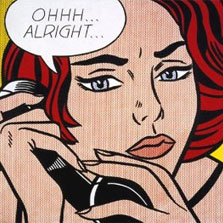| Pop Art History > American | ||||
|
American Pop ArtAmerican pop art came about a few years after its British counterpart, emerging in the later 1950's through the work of artists like Jasper Johns and Robert Rauschenberg.In a lot of ways, the movement was a response to the commercialism which was particularly prevalent in this post-Wold War II period, as many aspects of the mass media and of general pop culture, such as magazine ads and comic books, were incorporated in the artwork. Though it has its origins in the 1950's, American pop art did not truly come of age until the early 1960's, and in fact was not called “pop art” until this time. Early exhibitions of American pop art took place in the late 1950's in New York, while Andy Warhol in particular had his first exhibition in Los Angeles, where he sold his famous soup can paintings. One of the biggest differences between British pop art and American pop art was that British pop art focused on a more light-hearted tone and often tended to incorporate humor; American pop art, by contrast, was a product of the incessant marketing that Americans tended to be subjected to, and in order to differentiate itself from this more complex, even artistic mass media, the subject matter and tone tended to be more serious and dramatic. The somewhat less commercialized culture of Britain at the time allowed their pop art to take on more of a tone of parody. Some of the most prominent painters during the rise of pop art in the United States were Andy Warhol, Roy Lichtenstein, Tom Wesselmann. Roy Lichtenstein was notable as a founder of the movement in the U.S., and his work borrowed heavily from the art in American comic books. He was so respected as an artist at the time that Andy Warhol shifted away from comic books and onto other subject matter in response to Lichtenstein's superior representations of comic art. Andy Warhol himself rose to a legendary status as well, both during his own time and in later generations, his work resonating with a very wide audience. His pop art paintings remain some of the most expensive to ever be sold, with his Campbell's Soup Cans being particularly valuable; some examples of his art are worth many millions of dollars today, though he initially sold most of them for a relatively small sum. American pop art was a response to the culture at the time, which was mired in advertising and commercialism. Though pop art doesn't tend to openly criticize this state of affairs, it is heavily influenced by it, and in the same way that artists of the past were influenced by nature and religion, modern pop artists were influenced by the subjects that they were constantly exposed to—at the time, this was most often mass media. As a result, pop art resonated very deeply with the mass population, as, unlike many avant-garde movements before, it incorporated subject matter and techniques that a wide audience was already very familiar with.

|
|||||||||
| Pop Art History | What is Pop Art? | Origins of Pop Art | | British Pop Art | Independent Group | Artworks Top 10 Famous Artworks | Roy Lichtenstein | Richard Hamilton | Andy Warhol | Timeline | Dictionary | FAQ | Citations | References | Websites Pop Art History - All artworks copyright belong to the artist - Reproduction is strictly prohibited |

